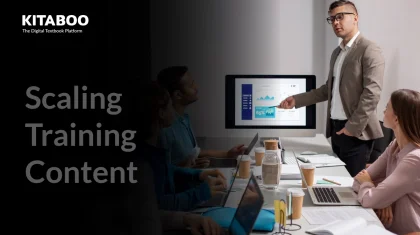
The Evolution of Education: Why Multimedia Textbooks are Here to Stay?
Summarize this blog with your favorite AI:
The education industry is constantly evolving to meet the needs of today’s tech-savvy generation, thanks to digitalization. This evolution has given rise to platforms like KITABOO, a digital textbook platform, and resulted in the development of multimedia textbooks.
Multimedia textbooks are eBooks that incorporate various forms of media, such as videos, audio, animations, images, graphs, and other interactive elements. Research has shown that multimedia textbooks can significantly increase students’ motivation to learn and, consequently, their academic achievement.
In this blog, we will delve into the significance of multimedia textbooks and their invaluable contribution to enhancing education.
Table of Contents:
I. Benefits of Multimedia Textbooks
- Deeper Understanding of Concepts
- Better Retention of Concepts
- Develop Problem-Solving Ability
- Foster Positive Emotions
II. Contribution of Multimedia Textbooks to Education
- Improved Educational Experience
- Increased Accessibility and Flexibility
- Personalized Educational Experience
- Cost-effective Education
- Immersive Educational Experience
- Enhanced Quality of Assessments
- Collaborative Educational Experience
III. The End Note
Benefits of Multimedia Textbooks
According to research, multimedia textbooks help to develop problem-solving abilities, promote a deeper understanding of concepts, and foster positive emotions.
Let’s explore the importance of multimedia textbooks in detail:
Deeper Understanding of Concepts
Multimedia textbooks support the brain in making the connection between the visual and verbal presentation of content.
The effective deployment of two channels—visual and auditory—enables learners to understand the content comprehensively and, thus, fosters a deeper understanding of concepts.
Better Retention of Concepts
A deeper understanding of concepts prompts the short-term memory to send the information gained forward to the long-term memory, fostering better retention of those concepts.
Information stored in long-term memory is relatively permanent and easier to recall when the occasion calls for it.
Develop Problem-Solving Ability
A large proportion of the human brain is responsible for visual processing. Thus, when multimedia elements accompany text, the brain gets stimulated, which consequently increases students’ attention.
This increased focus enables students to identify problems and solve them quickly.
Foster Positive Emotions
Using multimedia textbooks packed with fun media elements in the classroom influences students’ moods for the better.
When students feel positive emotions, as a result, they can see more possibilities in life. They tend to take a more proactive part in learning and thus learn concepts better.
Contribution of Multimedia Textbooks to Education
Since their advent, multimedia textbooks have contributed significantly to the field of education. The contributions of multimedia textbooks to education are as follows:
Improved Educational Experience
Multimedia textbooks have enhanced the educational experience of students. Multimedia textbooks provide a multisensory educational experience for students, engaging multiple of their senses with videos, animations, etc.
The stimulation of multiple senses increases students’ focus and improves the quality of their learning experience. In addition, the incorporation of media elements like images, graphs, audio, tables, etc., makes the educational experience feel fun and engaging, far removed from the monotonous experience associated with traditional textbooks.
Increased Accessibility and Flexibility
Multimedia textbooks have increased the accessibility of education to everyone, including people from the remotest parts of the state and people with disabilities. People with disabilities can benefit from using one form of media or another to study.
With multimedia textbooks, learners have the flexibility to study at a time that is convenient for them. Thus, they can juggle academics with part-time jobs or skill development activities.
Apart from time flexibility, learners also have the flexibility to study on a smart device of their choice since multimedia textbooks are device-agnostic.
Personalized Educational Experience
Every student has a different learning style. Some students prefer viewing visual content, while some students prefer listening to audio content. Multimedia textbooks are able to accommodate these varying styles by incorporating images, videos, audio, and animations in every chapter.
Apart from learning styles, multimedia textbooks make allowances for pace by allowing students to study at a pace that is comfortable for them.
In this way, multimedia textbooks have been able to personalize the educational experience for students.
Cost-Effective Education
Purchasing physical textbooks can be a costly affair. As a result, traditional textbooks can decrease the affordability of education. Unlike them, multimedia textbooks can increase the affordability of education since they cost much less than physical textbooks.
Additionally, even the upgraded versions of multimedia textbooks don’t cost much since they are easy to update and can be updated online only with slight modifications in the current version. Thus, multimedia textbooks stand as a cost-effective solution to education.
Immersive Educational Experience
Multimedia textbooks can often contain AR and VR-enabled videos. AR and VR technologies enable learners to experience the applications of theoretical concepts and phenomena in real life in 360 degrees.
For instance, with AR and VR videos, learners can virtually travel to historical sites, view the intricate structures of the brain, and stand on top of Mount Everest. In this way, VR and AR technologies enable learners to have immersive and captivating educational experiences.
Enhanced Quality of Assessment
Multimedia textbooks have enhanced the quality of assessments in education. Doing away with boring pen-and-paper assessments, they have brought in a broad range of interactive assessments.
Multimedia textbooks are usually incorporated with interactive quizzes, multiple-choice questions, case studies, and other types of assessments. They add an element of fun and thrill to the assessment experience and enable educators to evaluate different capabilities besides students’ academic performance.
Collaborative Educational Experience
Multimedia textbooks allow students to connect and collaborate in matters of education. Through multimedia textbooks, students can share highlighted passages and notes with each other.
In addition, they can engage in lengthy discussions by sharing comments. In such a way, multimedia textbooks enable students from all over the world to connect and engage, fostering the development of interpersonal skills.
The End Note
Multimedia textbooks have made a significant number of contributions to the field of education. They have improved and personalized educational experiences, increased educational accessibility and flexibility, enhanced the quality of assessments in education, and more.
As the influence of digitalization increases, the contributions and benefits of multimedia textbooks are also going to increase, making it imperative for academic institutions to incorporate multimedia-enabled textbooks in the future.
As an academic institution, if you want to enjoy a hassle-free incorporating experience, reaching out to KITABOO is key.
KITABOO is one of the leading online textbook platforms in the world. KITABOO allows you to create custom multimedia-rich content that is engaging, interactive, and immersive. In addition, KITABOO enables you to publish and distribute custom multimedia textbooks securely and at scale.
To know more, write to us at contact@kitaboo.com.
Discover how a mobile-first training platform can help your organization.
KITABOO is a cloud-based platform to create, deliver & track mobile-first interactive training content.


